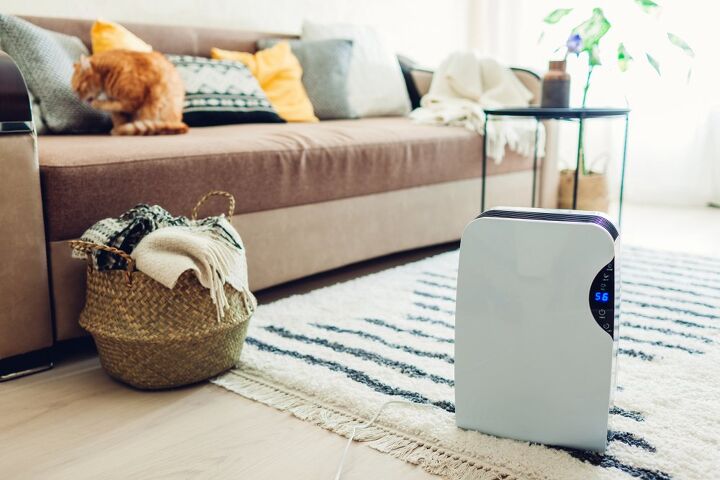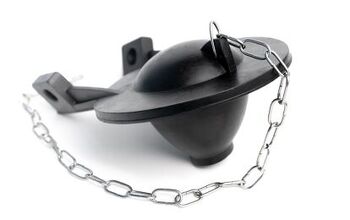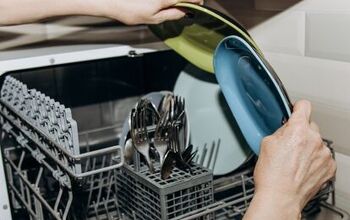Dehumidifier Coils Not Getting Cold? (We Have A Fix)

Depending on where you live, the inside of your home may get excessively humid. An easy fix is to run a dehumidifier to suck the hot air out of any room. But what happens when it’s not working properly, and you’re stuck sweating inside?
If you find yourself with a faulty dehumidifier, you may face things like the coils not getting cold. This often happens due to the compressor not working properly. It could also be low on freon, or the unit could just be old.
Below we’re going to talk about how to fix a dehumidifier and troubleshoot any issues it may be having. Before you know it, you’ll be relaxing inside at a comfortable temperature.
How a Dehumidifier Works
A dehumidifier works thanks to components like cold evaporator coils, a fan, warm condenser coils, and a tank that collects water. The fan is used to blow moisture from the air over the cold coils. Then, it condenses and drips into the water pan.
Dry air blows across the warm coils and back out into the room. Despite popular thinking, a dehumidifier doesn’t cool the air. It does reduce the amount of humidity in the air, making the room more comfortable.
It’s crucial to not use a dehumidifier in a room that’s cooler than 65 degrees. A humidistat in the unit can measure the room’s humidity, allowing the machine to work properly. If something is askew, like the coils not getting cold, it won’t take the moisture out of the air.
How to Fix a Dehumidifier
If you’re having issues with a dehumidifier, there are things you can do to get it working again. Here are the most common issues people face with this appliance.
Coils Not Getting Cold
One of the main reasons coils aren’t getting cold is because there isn’t enough airflow around the compressor. There could also be a refrigerant leak that could be causing the same issue.
If you find yourself with this issue, you could be adhesives that prevent the leak from continuing. Despite what we’re told, duct tape can’t fix everything. If you need more refrigerant, you’ll have to call an appliance repair specialist to access some.
Another thing that causes the coils to stay warm is a dirty dehumidifier. If there’s grime on the compressor or the coils, it may not work properly. Give it a thorough clean to see if that fixes the machine.
Does the dehumidifier work at all? If not, it could be the compressor motor or the overload switch has been tripped. You could replace these items, along with the fuses, to help the machine work properly again.
Machine Not Turning On
If the dehumidifier doesn’t work at all, here are some easy-to-follow steps you can take.
Step 1: Check the power and ensure it’s plugged in. You can try a few different outlets to ensure it’s a problem with the machine and not an electrical issue.
Step 2: Check the appliance power cord and look for any damage. If necessary, you can replace the power cord.
Step 3: Take off the cover panel and look for a lot of ice. If there is any ice blocking parts, allow it to melt. Be sure to only use a dehumidifier in a room that exceeds 65 degrees.
Step 4: Next, remove and test the overflow cutoff switch. You’ll need a volt-ohm meter for this step. Clip the leads to the terminals on the switch and depress the bar. If there is no continuity on the meter, the switch is likely faulty and in need of replacement.
You can also turn the humidistat’s knob in both directions to see if the volt-ohm meter registers zero ohms. If it does, that’s a sign that the dehumidifier is working. If it stays at zero while you’re turning the knob, the machine is broken.
Step 5: If the unit still isn’t turning on, you can either buy a new dehumidifier or call a repair person. To prevent any safety concerns, many homeowners opt for replacing it with a new one.
Dehumidifier Overflows or Leaks
While it’s common for a dehumidifier to have a float switch that prevents it from spilling over water, the switch can go bad. If you find yourself with an overflowing dehumidifier, you can text the overflow switch using a volt-ohm meter.
Step 1: Unplug the dehumidifier and remove the switch. Then, you’ll want to disconnect the leads and replace them with the leads of the volt-ohm meter to the terminals on the switch.
Step 2: Check the tank to see if there’s any water. If there is, be sure to empty it and check to see that the drain isn’t clogged before putting it back.
Step 3: Straighten the unit’s hose and get rid of any bending that could occur.
Step 4: Put the volt-ohm meter to the RX1 scale and depress the trip lever on the switch. Watch it as it clicks back and forth. If there is no continuity, the switch will need replacement.
How to Clean a Dehumidifier
Sometimes a simple fix like cleaning the dehumidifier can get it up and running again. You’ll want to ensure it’s unplugged and consider taking it outdoors to work on it. Here’s how you can properly clean the appliance.
Step 1: Get two spray bottles. Fill one with full-strength white vinegar and fill the other with full-strength hydrogen peroxide.
Step 2: Remove the drip reservoir and empty it completely. Spray down the inside of the reservoir with the vinegar and the drawer it was pulled from. Let the liquid sit for around 15 minutes before rinsing it with water.
If you have grime on the inside, you can use a microfiber cloth and wipe down the area. Follow up using the hydrogen peroxide and repeat the soaking and rinsing steps.
Step 3: Next, you’ll want to clean the coils using a cheap coil-cleaning brush. Carefully scrub off what you can before spraying it down with the vinegar. Allow it to sit for 10 minutes before rinsing it off.
Wipe the coils clean and repeat the process using hydrogen peroxide. Let the appliance dry for at least 24 hours before using it.
Step 4: Clean the filter by removing it and spraying it down with water. Next, add in the vinegar mixture and let it sit for 10 minutes. Rinse it and spray it hydrogen peroxide and allow it to sit for an additional 10 minutes.
Rinse the filter again and wipe it down with a sponge. Allow it to air dry before putting it back in the unit.
Step 5: Wipe the fan blades clean by removing the cover and wiping them down with a damp cloth. You can also add a couple of teaspoons of baking soda to the tank to prevent any bad odors.
Be sure to empty your humidifier as soon as the tank is full to prevent things like bacteria or mold growth.
Cost of a Replacement Dehumidifier
Dehumidifiers can be fairly affordable to run. This chart shows what you can expect to pay for a brand new 30-pint unit. Keep in mind these are average prices, and some appliances fall under and over these prices.
| Cost of New Dehumidifier | Place of Purchase |
| $169 | Home Depot |
| $189 | Lowe’s |
| $143 | Menards |
| $162 | Walmart |
| $147 | Target |
| $130 | Amazon |
Related Questions
How cold should a dehumidifier coil be?
While it can depend on the specific dehumidifier, most should not be operated in temperatures below 60 degrees. This is because the moisture removed from the indoor air can freeze once it becomes condensed. If this happens, the cooling coils on the unit can become damaged.
Why is my dehumidifier blowing cold air?
The coils on the evaporator of a dehumidifier should get extremely cold while it’s running. The air that’s sucked in from the fan to the coils becomes condensed. If the room is already too cool to run the unit, it can end up blowing cold air.
How do I know if my dehumidifier is working properly?
There are a couple of ways of knowing if your dehumidifier is properly working. There should be an indicator light that shows it’s powered on, and you’ll be able to hear the fan start. You’ll also be able to notice by the tank filling up with water over time.

Kirstin is a passionate writer who loves helping people learn new things when it comes to home improvement. When she's not behind a keyboard, she enjoys DIY projects, crafts, spending time with her pets, and making videos. She hopes that with all she writes, someone is finding a solution to their home improvement needs.
More by Kirstin Harrington



























